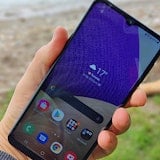 The Samsung Galaxy S 2 is receiving a lot of attention right now, both from the media and from customers themselves. Quite rightfully so, the Galaxy S 2 is Samsung’s new flagship device and the rightful heir to the original Samsung Galaxy S throne. It’s currently the best-selling top-end Android device in the world but does it deserve to be? We take a look to see if the Galaxy S 2 really does live up to all the hype.
The Samsung Galaxy S 2 is receiving a lot of attention right now, both from the media and from customers themselves. Quite rightfully so, the Galaxy S 2 is Samsung’s new flagship device and the rightful heir to the original Samsung Galaxy S throne. It’s currently the best-selling top-end Android device in the world but does it deserve to be? We take a look to see if the Galaxy S 2 really does live up to all the hype.
Physical Features of the Samsung Galaxy S 2
At the outset the Galaxy S 2 is sleek and stylish in appearance. There isn’t an over-abundance of unique design in the shape or contours of the handset itself, but its super-thin profile couple with a large screen and slightly sharpened edges work together well to create an aura of minimalistic class.
We were a bit underwhelmed with the thin plastic rear plate, which was clearly designed to minimize the profile, rather than focus on durability or a reaffirmation of quality. It actually makes the handset feel a bit cheaper than it really needs to and in no way adds any form of reassuring grip.
That being said we actually didn’t find the Galaxy S 2 all that difficult to hold. We’ve read more than one review that has commented on a noticeable discomfort when holding the GS2 in the hand, but we experienced none of this. That isn’t to say it was a pleasure to grip, it’s nothing special in that department when compared to curvier handsets, especially those with soft-touch material on their rear plates. But the Galaxy S 2 was definitely not uncomfortable either, and the sides actually did offer a decent amount of grip, if not in too much abundance.
Below the display are 2 capacitive “Back” and “Menu” buttons that are situated to each side of the hardware “Home” key. Samsung, like many other manufacturers,has done away with the classic Android “Search” key,in favor of freeing up a bit more room at the bottom of the handset. We didn’t really have any problem with this approach, as we rarely used the search function anyway.
One curiosity that Samsung seems to be sticking with is the idea of a right-side lock/power button. We’ve always found a side button to be a bit more of a hassle to get to than one situated at the top, as is the norm with most smartphones.
With the GS2 it became a particular problem as the left-hand volume rocker seemed to be in the exact place where we wanted to brace the opposite side of the phone when pressing the lock key. This caused us to unintentionally adjust our volume settings on more than one occasion. It was only an issue if when the Galaxy S 2 was held one-handed in the right hand, but it still seems like something that could have been easily avoided by shifting the volume rocker downwards a smidge.
Other than a bit of unfortunate placement the volume rocker actually worked quite well. It wasn’t difficult to press, yet we didn’t find too many accidental activations when carried in a pocket or bag. The 3.5mm headphone jack, located at the top, also worked without dramas. We didn’t once have ruffle around our jeans because of a suddenly disconnected headset.

Display and User Interface
The 4.3 inch, Super AMOLED Plus display of the Samsung Galaxy S 2 is, perhaps, it’s greatest feature. Colors are hands-down the most vibrant that we’ve seen on any handset. Blacks are astonishingly black and whites come out a crisp and clear. The display itself loses almost none of its splendor when viewed on even extreme angles. It has has been chastized a bit for sporting a 480 x 800 resolution; the same resolution as most of the last generation of phones. Conversely, the HTC Sensation and Motorola Atrix both sport resolutions of 540 x 960, which is especially impressive on the Atrix, as it has a smaller screen at just 4 inches.
The lack of resolution was a bit of a shame, but we honestly have to say that we preferred the bump in color brightness and focus on black-tones over a slightly crisper image. This is of course a purely subjective area and, as such, it’s up to each individual to make their own choice over. But it’s very difficult to go back from a screen with the vibrancy and life of the Galaxy S 2 once you’ve become accustomed to it.
One small issue we did find was that, when not set to the brighter side of the settings, there was some issue in direct sunlight. So if you’re the kind of user to run their phone on Automatic settings (i.e. it gets darker the less battery you have) then you’ll find yourself squinting pretty often on sunny days. However, switching the screen to full brightness immediately fixed the problem and was very easy to do from the home screens of the GS2’s user interface (UI).
The Samsung Galaxy S 2 has 7 Home Screens, the primary of which is located furthest to the left. It seems like a very “HTC Sense-esque” design with a weather widget taking up the top half of the main screen and 2 rows of icons underneath. A pinch-to-zoom command quickly expands the view out to encompass all 7 Home Screens, another which really doesn’t help to set it apart from HTC Sense, but it’s still a great feature. It’s not a particularly bad thing for the user that Samsung is mirroring Sense, as we love this style of interface. But it would be nice to see something original out of Samsung in the UI department, just once.
Missed calls and messages were available directly on the Lock screen. Missed calls appeared on the left and messages on the right, each could be easily accessed by a swipe that took the user straight to the call or text in question. We love functionality like this on lock screens and would like to see it start being more widely employed. We would have preferred to have seen a camera option there as well for those moments when a photo op needs to be taken advantage of quickly too, but we guess we can't have everything... yet.

There are, of course, a variety of widgets for the user. Our favorite of these was the calendar widget, which showed a full month at a time and had a space below to display any appointments or events you might have on today. The calendar synced well with Facebook, Gmail and a variety of other social media options and internet profiles. All in all it was a very normal calendar app that managed to bring itself above the norm by providing a more polished experience than we’ve generally experienced previously.
The Menu screen was, disappointingly, unchanged from Samsung’s other devices. If you’re unfamiliar with Samsung’s Touchwiz interface then let’s just say it looks very similar to another very famous line of handsets. Scrolling between menu screens from side-to-side just doesn’t feel as fluid or easy as the up/down motion of most Android handsets, especially seeing as the Android menu isn’t designed for you to arrange your icons in easy-to-access little pages; that’s what the Home Screens are for.
Loading apps, either from the Home Screen or in the Menu, was fast and responsive. Scrolling between screens was smooth, as was switching between the zoomed-out mode and the standard view. Overall multitouch commands were accurate, fast and very rarely suffered from any forms of lag.
We did find Samsung’s Kies syncing service to be a bit on the odd side. Most Android devices will give you options when syncing your device. Kies seemed to have 2 modes when plugged in to a computer; Charge Only and Mount as USB Device (while charging). There was also the odd problem of not being able to grab songs straight from a media player’s playlist and drag them in to a folder on the device itself. Rather, files could only be copied over directly from the drive or folder in which they were stored on the computer.
This was actually pretty annoying, as we have a multitude of playlists we enjoy and it would have saved a tonne of time if we could have just opened them up and dragged the songs across, as we’ve done on every other Android device we’ve tested. We solved the problem by creating a new folder on the desktop, dragging the songs in to it (essentially creating a bunch of copies), then cutting and pasting that folder to the Galaxy S 2 itself. It didn’t take too much longer, but it seems like a completely unnecessary step.
We should mention Samsung Kies did work wirelessly over WiFi, which is a great function but is becoming more common place in Android handsets.
Power, Memory and Battery Life
The dual-core 1.2GHz processor of the GS2 is an absolute monster. It destroyed everything we threw at it without missing a beat. Although we did find that when charging or using 3G intensive programs that we got a bit of a heat build-up on the back of the handset where the CPU is located. It wasn’t a huge deal for us and was centralized at the top of the device, so didn’t impede too badly on where we held the phone. However, we can see it being a bit annoying for anyone who likes to keep their phone in a chest pocket of a jacket or shirt. We’re also not sure how the Galaxy S 2’s heat problem would be affected by keeping a solid case wrapped around it. We used ours with a thin case that had numerous holes through which heat could escape, so we never got any huge build-ups.
As odd as it sounds, the heat build-up certainly wasn’t enough to throw us off and actually didn’t cause any real problems for us. The CPU was fast enough to make up for the small inconvenience, the 1GB of RAM handled multitasking absolutely fantastically and the battery, surprisingly, lasted a full day. It’s true that at 1650mAH the battery on the Galaxy S 2 is a bit more gutsy than on less powerful phones, but we were still pleased to see a dual-core device with a 4.3 inch Super AMOLED Plus display lasting a full day at medium-to-heavy use.
Of course, if you’re going to run a lot of video media of 3G intensive services then your battery life is going to suffer significantly and will need to charge before the day’s end, but this is true of most top-end devices these days. When it comes to charging the GS2 certainly takes its time. It often took a good 2-3 hours to charge from a wall socket and when charging from a computer via USB you’ll be waiting at least a solid 3 (if not more) hours if you’re completely out of battery. But we did find that when we charged from a desktop that there were none of the previous heating concerns.
As far as standard internal memory goes the GS2 sports 16GB of on-board storage. It’s important to remember that some of this storage is already taken up by the operating system (OS), as well as other programs when you get it. But you still have a lot of room to play with. There’s also a MicroSD slot that takes up to 32GB of extra memory if you think you’ll need it, so there’s plenty of memory to go around for all those media junkies out there.
Media Playback on the Samsung Galaxy S 2
The Galaxy S 2 is possibly the best handset we’ve ever used for media playback. There, we’ve said it. Aside from the small file transfer issue we mentioned in the UI section with Samsung Kies, we were extremely happy with our media experiences on the GS2.
The Music player actually offered decent quality music. Most people wouldn’t really notice the difference without a direct comparison, but we tend to listen to a lot of music here and when we’re out and about. We’ve always found Android devices to lack a certain depth of quality with their music players, especially when compared to certain other market-leading handsets.
The Galaxy S 2, however, didn’t really have this problem. Now before all those music enthusiasts out there start bashing down our doors we’re only saying that the GS2 has a good music player, not an amazing one. Of course a phone will never compare to a dedicated portable music device, but this phone is at least a minor cut above some of the competition. The speaker itself is also surprisingly loud, if not of amazing quality. So if you’re ever in a pinch for some music when hanging with your mates you can just plonk the GS2 down and crank it up. It’s not a perfect solution, but it definitely made for a passable stand-in on a few occasions.
Although, if you’re going to do this you’ll need to change a setting in the Motion section of the Settings menu. The setting in question is called Turn Over and it mutes all sound when the Galaxy S 2 is laid screen-down. This is problematic because the speaker for the GS2 is located on the back, so you’ll need that to be facing upwards if you want to play music through it. It’s also worth turning off anyway, as we found that our music player would often stop dead in our pocket when we sat down. Yes, it mutes headphone sound too. We can’t actually figure out why this setting is default-set to ‘on’, but it’s easy enough to turn off.
Video playback really benefitted from the aforementioned vibrancy of the Super AMOLED Plus display. It was refreshing to view our shows on such a bright screen, especially one with such great viewing angles. This is probably the only area where we really noticed the lower 480 x 800 resolution holding the GS2 back, however. HD video files didn’t look bad, but were noticeably more pixelated at times than on the Motorola Atrix. Once again this is an area where one has to choose between vibrancy and resolution and is solely up to the personal preferences of the individual.
It was also extremely easy to convert video files to the types supported by the GS2. Just copy and paste your files straight in to the device and a pop-up will appear. The phone asks you if you wish to just store the files straight on the hard drive (of course it warns you that they are unsupported and thus cannot be played) so as to use the phone as nothing more than portable storage, or it actually offers to convert the files for you right on the spot. This process doesn’t take longer than any other software conversion programs we’ve ever used and is an almost totally hassle free way of solving file-support issues for video content. Unfortunately this same technique doesn’t seem to apply to music files, but most people already have their music in MP3 form these days anyway.
One quick final bit we’ll mention is that the Galaxy S 2, coming from Samsung, has Samsung’s All-Share function. This is a super-easy way by which the GS2 can be wirelessly synced with any Samsung Smart TV. Just activate All-Share on both devices and then you can literally just stream video content from your phone to your TV over-the-air, so long as they’re both connected to the same WiFi network. We loaded up on episode of Arrested Development as a test and it started playing after only about 9 seconds. The quality was fantastic and there weren’t any buffering issues mid-video. A quick warning though, All-Share absolutely smashes battery power, you’ll get a max of 3 hours out of the GS2 if you’re streaming content, so be careful.

Camera, Video and Call Quality
The 8MP camera was pretty good. We were very impressed with how most photos came out in good light and motion didn’t seem to be too much of a problem. That being said the camera on the GS2 is still pretty standard for a top-end device. It suffered significantly in low light and had a bit of trouble with focusing too much on bright objects when the flash was employed. These problems were no more severe than on any other current device with an 8MP camera, but we were expecting a little better from the GS2.
We would also liked to have seen a dedicated camera button. It's not a huge issue but anyone who's ever had a phone with a hardware camera button will tell you how much easier it is to line up a good shot and keep it steady. We understand that manufacturers want to keep their devices minimalistic in the button department, but we would really love to see a wide-spread adoption of this feature.
The 1080p video capture is fantastic. We took a few quick vids in multiple lighting situations and they all came out really well, all except those done outside at night of course. The videos were even still enjoyable when thrown on a 55 inch LED TV. Obviously you’re not looking at Blu-Ray quality here and you should never be fooled in to thinking that “1080p” means you’ll be shooting high-grade HD movies. But it was definitely the best quality video we’ve shot on a phone so far.
The front-facing camera was passable for video calls. We didn't find ourselves using it too much though, mainly because the GS2 comes running Android 2.3.3 and not 2.3.4. Basically 2.3.4 comes with some nifty video support via the Google Talk app and is pretty much Google's answer to Apple FaceTime. Without this support we just stuck to traditional voice-only calls.
Standard call quality was actually a bit lacking. The ear speaker and mic for the GS2 seemed to be noticeably worse than what we're used to on other phones. It was exactly the same problem we encountered with the original Samsung Galaxy S phone; voices were still distinguishable and we rarely had trouble being heard on the other end, but it's still surprising that we should have an issue with this at all with such a high-end modern handset. Especially considering we had no such issues when we reviewed the Google Nexus S, which was manufactured by Samsung and had very standard call quality.

Messaging and Web Browsing on the GS2
Messaging on the GS2 was fantastic. The large screen made it easy for our large thumbs to zip around and no matter how fast we typed we never managed to go beyond the limits that the Galaxy S 2 could handle. Swype was also smooth and lag-free, so whether you prefer sliding or tapping your fingers you’ll still have a fluid experience.
As a result emails and other textual communication was great as well, especially considering that the 4.3 inch screen gave plenty of room for reading incoming messages.
Web browsing was a similarly pleasant experience. The browser was fast, the display made sure that web-pages were vibrantly colorful and the large screen came in handy once again. Pinch-to-zoom was very smooth thanks to the CPU & RAM and there were none of the resizing issues we encountered on the Motorola Atrix and Motorola DEFY when switching between portrait and landscape modes. Flash support was also there, of course, and we found that it didn’t seem to slow down the browser too much.

The WhistleOut Opinion
We know that everyone has different tastes and that not every customer is looking for the same experience in a smartphone. As such we try not to get too excited about individual devices here at WhistleOut; just because we love a device doesn’t mean everyone else will. But in the case of the Galaxy S 2 we would definitely have to wholly recommend it.
Yes there are issues with heating, the screen could use a few more pixels and the back plate is a bit too plastic in feel. It takes a while to charge and call quality might not have been the greatest. However, these issues were, to us, extremely minor.
The pros of the Galaxy S 2 are its smooth user experience, it’s stunningly colorful screen, its media playback, it’s great (if not uniquely amazing) camera, its fast browser, effortless texting, its intuitive (but not original) UI and it’s amazing dual-core CPU. The Samsung Galaxy S 2 definitely deserves its current spot as top-dog in the Android race and is a fantastic option for anyone looking for a high-end Android device, or who is even just looking for another solid handset to compare.
Check out prices, plans and deals on the Samsung Galaxy S 2



Related Articles
Related Topics
Samsung Android Gingerbread Samsung Galaxy S IIPopular Topics
Android Apple Samsung iPhone Google Cell phone plans iOS Rogers Telus HTCFind Better Phones and Plans
Hundreds of cell phone plans unpacked. All the facts. No surprises.










































